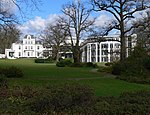Klein Flottbek station
Buildings and structures in Altona, HamburgGerman rapid transit stubsHamburg S-Bahn stations in HamburgHamburg railway station stubsHamburg stubs ... and 1 more
Railway stations in Germany opened in 1867

Klein Flottbek (Botanischer Garten) railway station is on the Altona-Blankenese line and serviced by the Hamburg city trains. Rapid transit trains of lines S1 and S11 of the Hamburg S-Bahn call at the station in the Klein Flottbek subdistrict in the Nienstedten quarter of Altona borough in Hamburg, Germany. The track forms the border of the Osdorf quarter. The station is near the main entrance of the Botanischer Garten Hamburg, in Osdorf.
Excerpt from the Wikipedia article Klein Flottbek station (License: CC BY-SA 3.0, Authors, Images).Klein Flottbek station
Am Klein Flottbeker Bahnhof, Hamburg Nienstedten (Altona)
Geographical coordinates (GPS) Address Nearby Places Show on map
Geographical coordinates (GPS)
| Latitude | Longitude |
|---|---|
| N 53.558055555556 ° | E 9.8611111111111 ° |
Address
Am Klein Flottbeker Bahnhof 2
22609 Hamburg, Nienstedten (Altona)
Germany
Open on Google Maps









